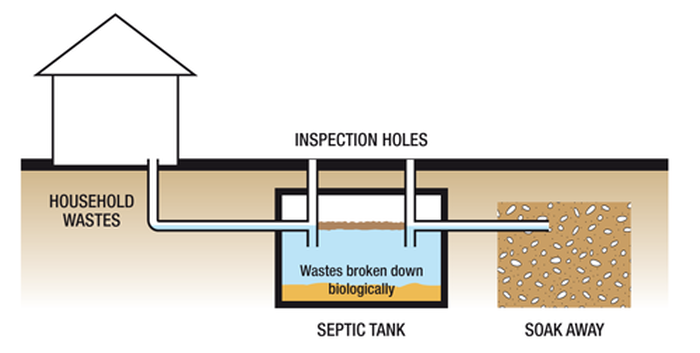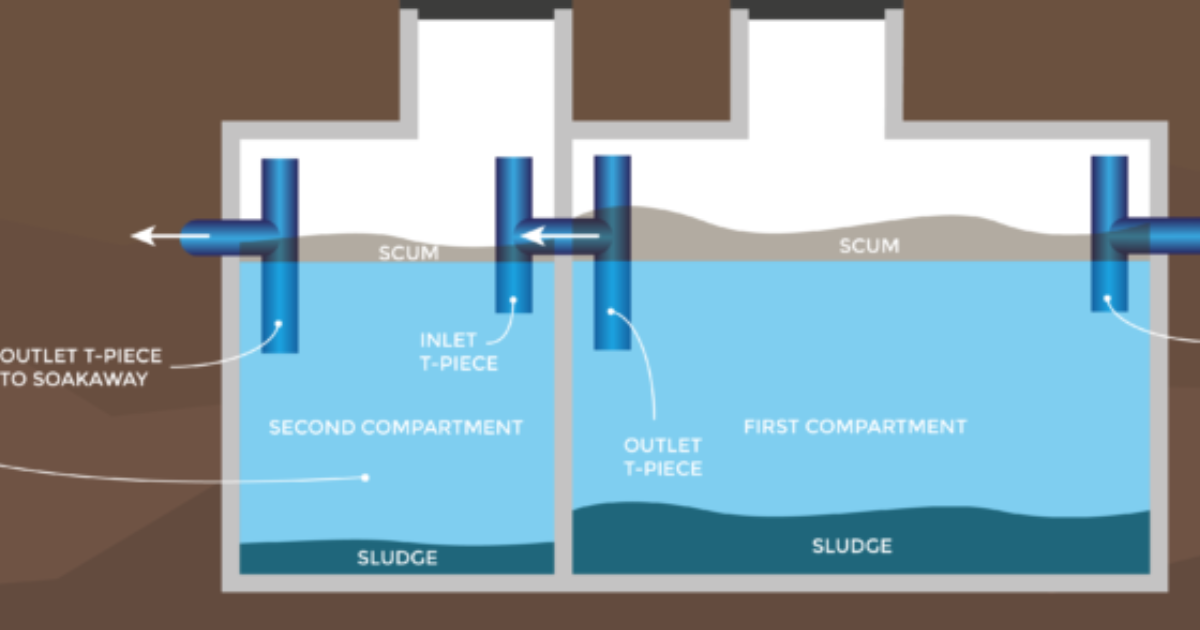Have you ever wondered about the difference between a septic tank and a soakaway? Many people use these terms interchangeably, but in reality, they serve distinct purposes in a wastewater management system. A septic tank is a container that holds and treats sewage, while a soakaway is an underground system designed to disperse treated wastewater into the surrounding soil. In this article, we will explore the functions and characteristics of both septic tanks and soakaways, helping you gain a comprehensive understanding of these essential components of residential sewage systems.

This image is property of sites.create-cdn.net.
Septic Tank
Definition
A septic tank is a sewage treatment system that is commonly used in areas where there is no access to a centralized sewer system. It is an underground container made from concrete, fiberglass, or plastic, and it is designed to collect and treat wastewater from residential or commercial properties.
Function
The primary function of a septic tank is to separate solid waste from the wastewater and allow the liquid portion to flow into the drain field for further treatment. The tank utilizes a series of chambers and baffles to facilitate the natural breakdown of organic matter by bacteria. This process, known as anaerobic digestion, helps to reduce the volume of solids and eliminate harmful pathogens.
Installation
Installing a septic tank involves several steps and should be carried out by a professional. First, the soil is tested to determine its suitability for a septic system. Then, the tank is selected based on the size and needs of the property. The tank is carefully installed below the ground, ensuring proper placement, and connected to the property’s plumbing system.
Components
A typical septic tank consists of an inlet pipe, an outlet pipe, a distribution box, a drainage field, and a riser for easy access. The inlet pipe allows wastewater to enter the tank, while the outlet pipe allows the treated liquid to flow out. The distribution box evenly distributes the liquid effluent into the drain field, where it percolates through layers of soil for further treatment before reaching the groundwater.
Tank Size
The size of a septic tank is determined by the number of bedrooms in a property or the daily wastewater flow. Larger properties or those with higher water usage require larger tanks. It is crucial to choose the right size to ensure adequate treatment capacity and prevent overflow or system failure.
Maintenance
Regular maintenance is essential to keep a septic tank functioning properly. This includes pumping out the tank every few years to remove accumulated solids, inspecting the tank for leaks or cracks, and keeping the drain field clear of any obstructions. It is also important to conserve water usage and avoid flushing harmful substances such as chemicals, oils, or non-biodegradable items down the drains.
Costs
The cost of installing a septic tank can vary depending on factors such as the size of the tank, the complexity of the installation, and the location. On average, the cost can range from a few thousand dollars to tens of thousands of dollars. Additionally, there are ongoing maintenance costs, including periodic pumping, which can range from a few hundred dollars to over a thousand dollars.
Efficiency
Septic tanks are known for their efficiency in treating wastewater, as they rely on natural processes and do not require electricity. With proper sizing and maintenance, a septic tank can effectively treat wastewater and protect the environment by reducing the pollution of groundwater and nearby water bodies.
Advantages
One of the main advantages of a septic tank system is its versatility. It can be installed in various locations, including rural areas or properties with challenging soil conditions, where a centralized sewer system is not feasible. Additionally, septic tanks provide a level of independence from municipal services and allow property owners to manage their own wastewater treatment.
Disadvantages
Despite their many benefits, septic tanks have some drawbacks. The main disadvantage is the potential for failure if not properly maintained or if the system is overloaded. A failed septic system can lead to unpleasant odors, groundwater contamination, and costly repairs. Moreover, the installation and maintenance processes require professional expertise, adding to the overall expenses associated with a septic tank system.

This image is property of questwaste.co.uk.
Soakaway
Definition
A soakaway, also known as a septic drain field or leach field, is an integral part of a septic tank system. It is a network of perforated pipes or chambers buried underground, designed to receive and disperse the treated liquid effluent from the septic tank into the surrounding soil.
Function
The primary function of a soakaway is to facilitate the final stage of wastewater treatment by allowing the effluent to percolate into the soil. As the effluent passes through the perforations in the pipes or chambers, it slowly seeps into the soil, where further natural processes take place to remove any remaining contaminants before the water reaches the groundwater.
Installation
Installing a soakaway involves careful planning and adherence to local regulations. The location of the soakaway is determined based on soil conditions, distance from water sources, and the size of the property. The pipes or chambers are laid in trenches or gravel beds and covered with soil, ensuring proper drainage and permeability.
Components
A typical soakaway comprises perforated pipes or chambers, a distribution box, and gravel or a bed of aggregate material. The perforated pipes or chambers allow the effluent to disperse into the soil, while the distribution box evenly distributes the effluent across the system. The gravel or aggregate bed provides support and aids in the proper flow of effluent.
Size
The size of a soakaway is determined based on the volume of effluent generated by the septic tank and the absorption capacity of the surrounding soil. It is crucial to ensure proper sizing to prevent oversaturation of the soil, which can lead to system failure and environmental contamination.
Maintenance
Regular maintenance of a soakaway is crucial to ensure its proper functioning. This includes periodic inspection of the distribution box, checking for any signs of blockages or damage to the pipes or chambers, and proper vegetation management around the area. It is important to avoid heavy traffic or construction activities over the soakaway to prevent compaction of the soil.
Suitability
Soakaways are suitable for properties with proper soil conditions that allow for adequate drainage and absorption of the effluent. However, they may not be suitable for all types of soil, such as clay or highly saturated areas, as these soils do not allow for sufficient percolation. In such cases, alternative wastewater treatment systems may need to be considered.
Costs
The cost of installing a soakaway can vary depending on factors such as the size of the system, the complexity of the installation, and the soil conditions. On average, the cost can range from a few thousand dollars to tens of thousands of dollars. Additionally, there are ongoing maintenance costs, including periodic inspections and potential repairs, which should be considered.
Advantages
One of the main advantages of a soakaway is its ability to effectively treat wastewater and disperse it into the soil, reducing the risk of groundwater contamination. Soakaways also have a relatively low impact on the landscape, as they are often covered with soil or vegetation. Additionally, they can be more cost-effective than other types of wastewater treatment systems, especially in areas where the installation of a septic tank is not feasible.
Disadvantages
Despite their advantages, soakaways have some limitations. They require suitable soil conditions, and not all properties may have the necessary soil characteristics for a successful installation. Additionally, regular maintenance is essential to ensure the proper functioning of the soakaway, and failure to do so can lead to system failure and costly repairs. It is crucial to consult with a professional to determine the suitability of a soakaway for a specific property.

This image is property of www.ukdpsolutions.co.uk.

